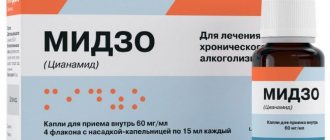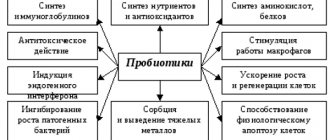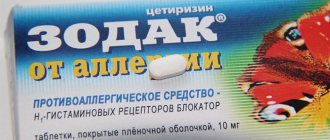Sinekod drops for internal use 5mg/ml 20ml
Compound
Composition (per 1 ml): Active ingredient - butamirate citrate 5 mg/ml.
Excipients - sorbitol solution 70% m/m 405 mg, glycerol 290 mg, sodium saccharinate 1.15 mg, benzoic acid 1.15 mg, vanillin 1.15 mg, ethanol 96% v/v. 3 mg, sodium hydroxide 30% m/m 0.5 mg, water up to 1 ml.
Pharmacokinetics
Butamirate is quickly and completely absorbed when taken orally. After taking 150 mg of butamirate, the maximum plasma concentration of the main metabolite (2-phenylbutyric acid) is reached after approximately 1.5 hours and is 6.4 μg/ml. When the drug is re-administered, its concentration in the blood remains linear and no accumulation is observed. Hydrolysis of butamirate, initially to 2-phenylbutyric acid and diethylaminoethoxyethanol, begins in the blood. These metabolites also have antitussive activity.
Like butamirate, the metabolites have an almost maximum (about 95%) degree of binding to plasma proteins, which, among other things, determines their long half-life from plasma. Metabolites are excreted primarily by the kidneys, with acidic metabolites largely associated with glucuronic acid. The half-life is 6 hours.
Indications for use
Symptomatic treatment of dry cough of various etiologies: cough in the preoperative and postoperative period, during surgical interventions, bronchoscopy, and whooping cough.
Contraindications
Hypersensitivity to the components of the drug, children under 2 months of age, pregnancy (first trimester), lactation period, fructose intolerance (the drug contains sorbitol).
With caution: Pregnancy (II and III trimesters). Due to the presence of ethyl alcohol in the drug, use with caution in patients with a tendency to develop drug dependence, with liver diseases, alcoholism, epilepsy, brain diseases, pregnant women and children.
Directions for use and doses
The drug is taken orally, before meals. Children from 2 months to 1 year: 10 drops 4 times a day; from 1 year to 3 years: 15 drops 4 times a day; from 3 years and older: 25 drops 4 times a day. If the cough persists for more than 7 days, you should consult a doctor. Before using the drug in children under 2 years of age, you should consult your doctor.
Storage conditions
At a temperature not exceeding 30 °C. Keep out of the reach of children.
Best before date
5 years. Do not use after expiration date.
special instructions
The drops contain saccharinate and sorbitol as sweeteners, so they can be prescribed to patients with diabetes. The drug contains a small amount of ethyl alcohol (2.81 mg/ml), less than 100 mg per dose. Due to the presence of ethyl alcohol in the drug, use with caution in patients with a tendency to develop drug dependence, with liver diseases, alcoholism, epilepsy, brain diseases, pregnant women and children.
Description
Transparent liquid, colorless to colorless with a yellowish tint, with a vanilla odor.
Conditions for dispensing from pharmacies
Over the counter
Dosage form
Drops for oral administration [for children].
Manufacturer and organization accepting consumer complaints
Novartis Consumer Health SA
Pharmacodynamics
Butamirate, the active substance of the drug Sinekod, is a centrally acting antitussive agent. It is not classified as an opium alkaloid either chemically or pharmacologically. Does not form dependence or addiction. Suppresses cough, having a direct effect on the cough center. Has a bronchodilator effect (expands the bronchi). Helps make breathing easier by improving spirometry (reduces airway resistance) and blood oxygenation (saturates the blood with oxygen).
Side effects
Classification of the frequency of occurrence of adverse reactions: very often (? 1/10); often (?1/100, <1/10); uncommon (?1/1000, <1/100); rarely (?1/10000. <1/1000); very rare (<1/10000), including isolated reports.
From the nervous system: Rarely: drowsiness
From the gastrointestinal tract: Rarely: nausea, diarrhea.
From the skin and subcutaneous tissues: Rarely: urticaria, possible development of allergic reactions.
Use during pregnancy and breastfeeding
In animal studies, no adverse effects on the fetus were observed. There have been no controlled studies in pregnant women. In this regard, Sinekod should not be used in the first trimester of pregnancy. In the second and third trimesters, the use of Sinecode is possible, taking into account the benefits for the mother and the potential risk for the fetus. Given the lack of data on the excretion of butamirate in breast milk, the use of Sinecod during lactation is not recommended.
Interaction
No drug interactions have been reported for butamirate. Due to the fact that butamirate suppresses the cough reflex, the simultaneous use of expectorants should be avoided to avoid the accumulation of sputum in the respiratory tract with the risk of developing bronchospasm and respiratory tract infection.
Overdose
Symptoms: drowsiness, nausea, vomiting, diarrhea, dizziness and decreased blood pressure.
Treatment: gastric lavage, taking activated carbon, maintaining vital body functions. There is no special antidote.
Impact on the ability to drive vehicles and operate machinery
Sinecode may cause drowsiness, so caution should be exercised when driving or performing work that requires concentration (for example, when operating machinery) after taking the drug.
Suction
Based on available data, it is assumed that butamirate ester is rapidly and completely absorbed and hydrolyzed in plasma, turning into 2-phenylbutyric acid and diethylaminoethoxyethanol. The effect of food on absorption has not been studied. The change in the concentration of 2-phenylbutyric acid and diethylaminoethoxyethanol occurs in proportion to the dose taken in the range of 22.5 mg - 90 mg. Butamirate is rapidly and completely absorbed when taken orally, measured concentrations are detected in the blood 5 - 10 minutes after taking doses of 22.5 mg, 45 mg, 1 hour when taking dosages at all 4 levels, the average is 16.1 ng/ml at oral dose of 90 mg.
Average plasma concentrations of 2-phenylbutyric acid are achieved within 1.5 hours; the maximum concentration was observed after a dose of 90 mg (3052 ng/ml); average plasma concentrations of diethylaminoethoxyethanol are reached within 0.67 hours; Cmax is observed after taking a dose of 90 mg (160 ng/ml).
Distribution
Butamirate has a large volume of distribution in the range of 81 - 112 l (adjusted for body weight in kg), as well as a high degree of binding to plasma proteins. 2-phenylbutyric acid has a high degree of binding to plasma proteins at all dosage levels (22.5 - 90 mg), averaging 89.3% - 91.6%. The ability of diethylaminoethoxyethanol to bind to plasma proteins is also detected, the average values vary between 28.8% and 45.7%. It is unknown whether butamirate crosses the placenta or is excreted in breast milk.
Metabolism
Hydrolysis of butamirate, which results in the formation of 2-phenylbutyric acid and diethylaminoethoxyethanol, which have an antitussive effect, occurs very quickly. 2-phenylbutyric acid undergoes further partial metabolism by hydroxylation in the para position.
Removal
Excretion of the three metabolites occurs primarily through the kidneys; After conjugation in the liver, the acidic metabolites are largely bound to glucuronic acid. Conjugates of 2-phenylbutyric acid are detected in urine in significantly higher concentrations than in blood plasma. Butamirate is detectable in urine within 48 hours, and butamirate excreted in urine during the 96-hour sampling period accounts for approximately 0.02, 0.02, 0.03, and 0.03% of 22.5 mg doses. , 45 mg, 67.5 mg and 90 mg, respectively.
As a percentage, butamirate is excreted in the urine in greater quantities in the form of diethylaminoethoxyethanol than unchanged butamirate or unconjugated 2-phenylbutyric acid.
The measured half-lives of 2-phenylbutyric acid, butamirate and diethylaminoethoxyethanol are 23.26-24.42, 1.48-1.93, and 2.72-2.90 hours, respectively.
Cough in children - to treat or not to treat
Previously, codeine was widely used and was considered the “gold standard” of antitussive drugs. Codeine, as an antitussive drug, acts as a precursor to a pharmacologically active substance. In the liver, under the influence of cytochromes P450 and 2D6, codeine is converted to morphine. Randomized studies have shown that for chronic nonproductive cough, morphine is effective in no more than 30–50% of cases. Evidence-based studies have convincingly shown that the effectiveness of orally administered codeine at a dose of 50 mg was no greater than that of placebo.14 The opioid effect of codeine also contributed to its withdrawal from practice.
Butamirate acts through a central mechanism that has neither chemical nor pharmacological connections with opioids. Due to the nonspecific anticholinergic effect, Sinekod relieves bronchospasm.
Butamirate (Sinekod) came into widespread practice. It has been used in Europe for quite some time as an over-the-counter antitussive drug.15 Butamirate acts through a central mechanism that has neither chemical nor pharmacological connections with opioids. Due to the nonspecific anticholinergic effect, Sinekod relieves bronchospasm. In an experiment on healthy volunteers, Sinekod (butamirate) suppressed cough provoked by capsaicin significantly more effectively than placebo.16 Sinekod demonstrated high effectiveness in the symptomatic treatment of nonproductive cough in whooping cough,17 post-viral bronchial irritation, pleural irritation, in the pre- and postoperative period, during bronchoscopy . Children under 3 years of age should take the drug in the form of oral drops.
Sinekod drops for oral administration for children are prescribed at the age of:
- from 2 months up to 1 year – 10 drops 4 times a day;
- from 1 to 3 years – 15 drops 4 times a day;
- from 3 years and older – 25 drops 4 times a day.
Sinekod syrup is prescribed at the following ages:
- from 3 to 6 years – 5 ml 3 times a day;
- from 6 to 12 years – 10 ml 3 times a day;
- from 12 years and older – 15 ml 3 times a day.
Sinecode is a highly effective and safe remedy for the treatment of dry cough in adults and children, and meets all the basic requirements for modern drugs. Butamirate is recommended as the drug of choice for the treatment of dry cough of any etiology, to suppress cough in the pre- and postoperative period during surgical interventions and diagnostic procedures in the respiratory tract.18
Sinekod
Sinecode (active ingredient - butamirate) is an original drug for the symptomatic treatment of dry cough of a wide variety of etiologies. Cough is a protective reaction of the body that occurs when receptors in the respiratory tract are irritated. In most cases, it indicates the presence of some disease, most often the respiratory system. Adequate pharmacotherapy of cough is the most important task facing modern medicine. After determining the exact cause of the cough, treatment of the underlying disease begins, which is supported by taking medications for symptomatic therapy, the action of which can be aimed both at suppressing the cough and at increasing its productivity (mucoactive drugs). Suppression of the cough reflex is required in cases of dry, non-productive cough that does not fulfill its cleansing function. Such a cough significantly worsens the quality of life of patients and can threaten hemodynamic disturbances in the thoracic region, vomiting, hemoptysis, and diaphragmatic hernia. Medicines that inhibit the cough reflex can affect the cough center (central action) or the sensitivity of cough receptors (peripheral action). Among the first, a distinction is made between narcotic and non-narcotic drugs. Moreover, despite all the effectiveness of narcotic drugs, their use is associated with many undesirable side reactions. A significant advance in the treatment of dry cough has been the creation of new centrally acting antitussive drugs, comparable in effectiveness to narcotic drugs, but without such a severe side effect. Of significant interest in this aspect is the centrally acting antitussive drug Sinecode from the Swiss pharmaceutical corporation Novartis. In terms of its chemical structure and pharmacological “habits,” the active substance of sinecode, butamirate, in no way resembles opium alkaloids. Unlike morphine derivatives, the effect of butamirate on the cough center is selective, due to which sinecode is devoid of sedative and analgesic effects, does not cause pathological dependence and does not depress the respiratory center.
The effectiveness of the drug does not decrease even with long-term treatment, and the peak of its effect is achieved after the first use. In comparison with other drugs of this pharmacological group, Sinecode is endowed with a number of advantages, the main of which are high efficiency, favorable safety profile and good tolerability. Clinical trials have shown that the drug causes virtually no unwanted side effects even after long-term use: only in rare cases can skin rashes, dyspeptic disorders and dizziness occur. As already mentioned, sinecode can be used for non-productive cough of any etiology, as well as for cough center hypersensitivity syndrome that occurs as a consequence of a previous respiratory disease. The drug not only reliably blocks all “body movements” of the cough center, but also exhibits an anti-inflammatory and expectorant effect, dilates the bronchi, reduces the resistance of the respiratory tract and promotes oxygen saturation of the blood. Clinical studies have demonstrated the effectiveness of sinecode against both new-onset and chronic debilitating dry cough. The drug is characterized by a pronounced, long-lasting and rapid therapeutic effect, which begins to manifest itself already 1 hour after administration (in which it is clearly superior to codeine-containing drugs). Butamirate is quickly and completely absorbed in the gastrointestinal tract. Its half-life is 6 hours. Not only butamirate itself has an antitussive effect, but also its metabolites formed in the blood.
Sinekod is available in two dosage forms: drops for oral administration and syrup. The drops are used in pediatric practice, starting from 2 months, and the syrup is indicated for adults and children from 3 years of age.




